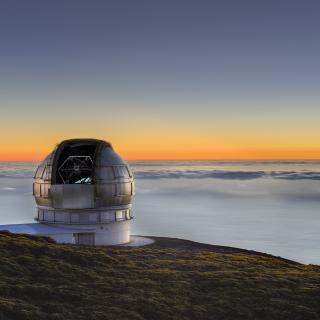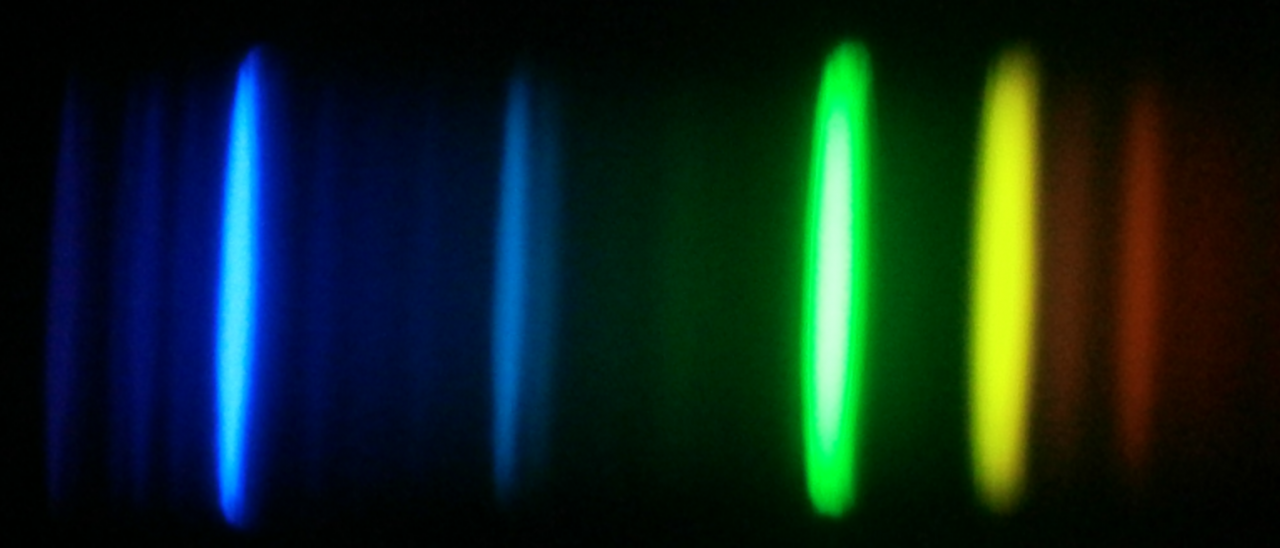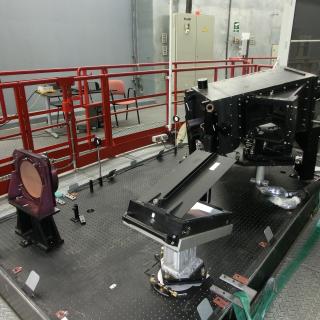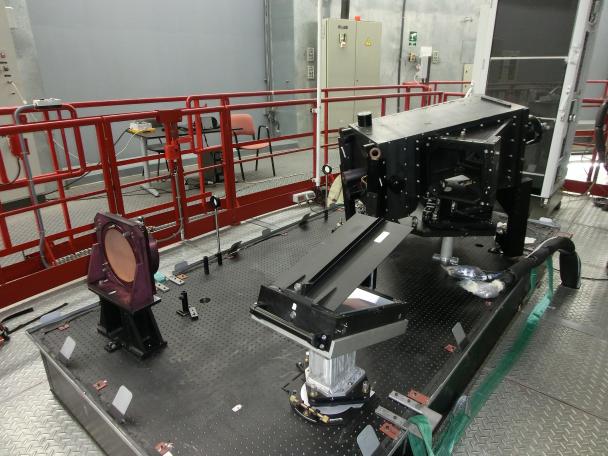Grants related:
General
Stellar spectroscopy allows us to determine the properties and chemical compositions of stars. From this information for stars of different ages in the Milky Way, it is possible to reconstruct the chemical evolution of the Galaxy, as well as the origin of the elements heavier than boron, created mainly in stellar interiors. It is also possible to study stellar formation, and the formation of the Galaxy, from the signature of the Galactic potential on the stellar orbits, and the distributions of mass, ages, and the abundance of heavy elements.
Obtaining high-resolution spectra, as necessary for studies of chemical compositions, requires advanced and efficient instrumentation. This is particularly true for research that calls for large stellar samples, which demands the observation of hundreds or thousands of sources simultaneously. Efficiency requires that the data processing and analysis are performed in an automated way.
The interpretation of spectra is based on physical models of the atmospheres of the stars, from where the light that we observe escapes the stars. The main ingredients for building such models are the fluid dynamics, and the properties of the atoms, ions, and molecules, especially regarding their interactions with the radiation coming from the stellar interior.
Once we have a plausible model, it is possible to compute in detail how the radiation propagates through the stellar atmosphere, and the emergent spectrum, which can then be iteratively compared with the observations to refine the model.
This project covers three different research fronts:
- Improving model atmospheres and simulations of stellar spectra.
- Developing tools for acquisition, reduction, and analysis of spectroscopic observations, in particular for the determination of chemical abundances in stars.
- Designing, preparing, and executing spectroscopic studies of stars aimed at understanding a) the most relevant aspects of the physics of stellar atmospheres, b) the formation and evolution of stars, c) the origin of the chemical elements, and d) the formation, structure, and evolution of the Milky Way galaxy.
Members
Results
- Complete the installation and commissioning of HORuS on GTC
- Discover two new stars with more than 100,000 times less iron than the Sun
- Complete the classification of all the APOGEE spectra with K-means
- Publish a complete collection of model stellar spectra for stars O to M
- Identify the signature of chemical diffusion in the atmospheres of the stars in the cluster M67
Scientific activity
Related publications
-
New ultra metal-poor stars from SDSS: follow-up GTC medium-resolution spectroscopy
Context. The first generation of stars formed in the Galaxy left behind the chemical signatures of their nucleosynthesis in the interstellar medium, visible today in the atmospheres of low-mass stars that formed afterwards. Sampling the chemistry of those low-mass provides insight into the first stars. Aims: We aim to increase the samples of stars
Aguado, D. S. et al.Advertised on:
72017 -
WHT follow-up observations of extremely metal-poor stars identified from SDSS and LAMOST
Aims: We have identified several tens of extremely metal-poor star candidates from SDSS and LAMOST, which we follow up with the 4.2 m William Herschel Telescope (WHT) telescope to confirm their metallicity. Methods: We followed a robust two-step methodology. We first analyzed the SDSS and LAMOST spectra. A first set of stellar parameters was
Aguado, D. S. et al.Advertised on:
92017 -
Sloan Digital Sky Survey IV: Mapping the Milky Way, Nearby Galaxies, and the Distant Universe
We describe the Sloan Digital Sky Survey IV (SDSS-IV), a project encompassing three major spectroscopic programs. The Apache Point Observatory Galactic Evolution Experiment 2 (APOGEE-2) is observing hundreds of thousands of Milky Way stars at high resolution and high signal-to-noise ratios in the near-infrared. The Mapping Nearby Galaxies at Apache
Mao, Shude et al.Advertised on:
72017 -
The Gaia-ESO Survey: Low-α element stars in the Galactic bulge
We take advantage of the Gaia-ESO Survey iDR4 bulge data to search for abundance anomalies that could shed light on the composite nature of the Milky Way bulge. The α-element (Mg, Si, and whenever available, Ca) abundances, and their trends with Fe abundances have been analysed for a total of 776 bulge stars. In addition, the aluminum abundances
Zaggia, S. et al.Advertised on:
62017 -
Gaia Data Release 1. Open cluster astrometry: performance, limitations, and future prospects
Context. The first Gaia Data Release contains the Tycho-Gaia Astrometric Solution (TGAS). This is a subset of about 2 million stars for which, besides the position and photometry, the proper motion and parallax are calculated using Hipparcos and Tycho-2 positions in 1991.25 as prior information. Aims: We investigate the scientific potential and
Zschocke, S. et al.Advertised on:
52017 -
Monitoring luminous yellow massive stars in M 33: new yellow hypergiant candidates
Context. The evolution of massive stars surviving the red supergiant (RSG) stage remains unexplored due to the rarity of such objects. The yellow hypergiants (YHGs) appear to be the warm counterparts of post-RSG classes located near the Humphreys-Davidson upper luminosity limit, which are characterized by atmospheric instability and high mass-loss
Kourniotis, M. et al.Advertised on:
52017 -
The Correlation between Mixing Length and Metallicity on the Giant Branch: Implications for Ages in the Gaia Era
In the updated APOGEE-Kepler catalog, we have asteroseismic and spectroscopic data for over 3000 first ascent red giants. Given the size and accuracy of this sample, these data offer an unprecedented test of the accuracy of stellar models on the post-main-sequence. When we compare these data to theoretical predictions, we find a metallicity
Tayar, Jamie et al.Advertised on:
52017 -
Timing the Evolution of the Galactic Disk with NGC 6791: An Open Cluster with Peculiar High-α Chemistry as Seen by APOGEE
We utilize elemental-abundance information for Galactic red giant stars in five open clusters (NGC 7789, NGC 6819, M67, NGC 188, and NGC 6791) from the Apache Point Observatory Galactic Evolution Experiment (APOGEE) DR13 data set to age-date the chemical evolution of the high- and low-α element sequences of the Milky Way (MW). Key to this time
Linden, Sean T. et al.Advertised on:
62017 -
Four new massive pulsating white dwarfs including an ultramassive DAV
We report the discovery of four massive (M > 0.8 M⊙) ZZ Ceti white dwarfs, including an ultramassive 1.16 M⊙ star. We obtained ground-based, time series photometry for 13 white dwarfs from the Sloan Digital Sky Survey Data Release 7 and Data Release 10 whose atmospheric parameters place them within the ZZ Ceti instability strip. We detect
Curd, B. et al.Advertised on:
22017 -
Baade's window and APOGEE. Metallicities, ages, and chemical abundances
Context. Baade's window (BW) is one of the most observed Galactic bulge fields in terms of chemical abundances. Owing to its low and homogeneous interstellar absorption it is considered the perfect calibration field for Galactic bulge studies. Aims: In the era of large spectroscopic surveys, calibration fields such as BW are necessary for cross
Schultheis, M. et al.Advertised on:
32017 -
Chemical tagging with APOGEE: discovery of a large population of N-rich stars in the inner Galaxy
Formation of globular clusters (GCs), the Galactic bulge, or galaxy bulges in general is an important unsolved problem in Galactic astronomy. Homogeneous infrared observations of large samples of stars belonging to GCs and the Galactic bulge field are one of the best ways to study these problems. We report the discovery by APOGEE (Apache Point
Schiavon, R. P. et al.Advertised on:
22017 -
Chemical Abundances of M-dwarfs from the APOGEE Survey. I. The Exoplanet Hosting Stars Kepler-138 and Kepler-186
We report the first detailed chemical abundance analysis of the exoplanet-hosting M-dwarf stars Kepler-138 and Kepler-186 from the analysis of high-resolution (R ∼ 22,500) H-band spectra from the SDSS-IV–APOGEE survey. Chemical abundances of 13 elements—C, O, Na, Mg, Al, Si, K, Ca, Ti, V, Cr, Mn, and Fe—are extracted from the APOGEE spectra of
Souto, D. et al.Advertised on:
22017 -
The Gaia-ESO Survey: Calibration strategy
The Gaia-ESO survey (GES) is now in its fifth and last year of observations and has produced tens of thousands of high-quality spectra of stars in all Milky Way components. This paper presents the strategy behind the selection of astrophysical calibration targets, ensuring that all GES results on radial velocities, atmospheric parameters, and
Pancino, E. et al.Advertised on:
12017 -
NLTE Analysis of High-resolution H-band Spectra. II. Neutral Magnesium
Aiming at testing the validity of our magnesium atomic model and investigating the effects of non-local thermodynamical equilibrium (NLTE) on the formation of the H-band neutral magnesium lines, we derive the differential Mg abundances from selected transitions for 13 stars either adopting or relaxing the assumption of local thermodynamical
Zhang, J. et al.Advertised on:
12017 -
Chemical trends in the Galactic halo from APOGEE data
The galaxy formation process in the Λ cold dark matter scenario can be constrained from the analysis of stars in the Milky Way's halo system. We examine the variation of chemical abundances in distant halo stars observed by the Apache Point Observatory Galactic Evolution Experiment (APOGEE), as a function of distance from the Galactic Centre (r)
Fernández-Alvar, E. et al.Advertised on:
22017 -
Galactic archaeology with asteroseismology and spectroscopy: Red giants observed by CoRoT and APOGEE
With the advent of the space missions CoRoT and Kepler, it has recently become feasible to determine precise asteroseismic masses and relative ages for large samples of red giant stars. We present the CoRoGEE dataset, obtained from CoRoT light curves for 606 red giants in two fields of the Galactic disc that have been co-observed by the Apache
Anders, F. et al.Advertised on:
12017 -
IMF and [Na/Fe] abundance ratios from optical and NIR spectral features in early-type galaxies
We present a joint analysis of the four most prominent sodium-sensitive features (Na D, Na I λ8190Å, Na I λ1.14 μm, and Na I λ2.21 μm), in the optical and near-infrared spectral ranges, of two nearby, massive (σ ˜ 300 km s-1), early-type galaxies (named XSG1 and XSG2). Our analysis relies on deep Very Large Telescope/X-Shooter long-slit spectra
La Barbera, F. et al.Advertised on:
12017 -
Evidence for a metal-poor population in the inner Galactic bulge
The inner Galactic bulge has, until recently, been avoided in chemical evolution studies because of extreme extinction and stellar crowding. Large, near-IR spectroscopic surveys, such as the Apache Point Observatory Galactic Evolution Experiment (APOGEE), for the first time allow the measurement of metallicities in the inner region of our Galaxy
Schultheis, M. et al.Advertised on:
122015 -
The SDSS-III APOGEE Spectral Line List for H-band Spectroscopy
We present the H-band spectral line lists adopted by the Apache Point Observatory Galactic Evolution Experiment (APOGEE). The APOGEE line lists comprise astrophysical, theoretical, and laboratory sources from the literature, as well as newly evaluated astrophysical oscillator strengths and damping parameters. We discuss the construction of the
Shetrone, M. et al.Advertised on:
122015 -
The Data Reduction Pipeline for the Apache Point Observatory Galactic Evolution Experiment
The Apache Point Observatory Galactic Evolution Experiment (APOGEE), part of the Sloan Digital Sky Survey III, explores the stellar populations of the Milky Way using the Sloan 2.5-m telescope linked to a high resolution (R ∼ 22,500), near-infrared (1.51–1.70 μm) spectrograph with 300 optical fibers. For over 150,000 predominantly red giant branch
Nidever, D. L. et al.Advertised on:
122015
Related talks
No related talks were found.Related conferences
No related conferences were found.News

The IAC is an internationalized Spanish research centre aiming to achieve major advances in the understanding of the laws that govern the origin and evolution of the various forms of matter/energy in the Universe. Outstanding results are expected in key areas of research such as Solar physics, Sun-Earth connections, Exoplanetary systems, Solar






